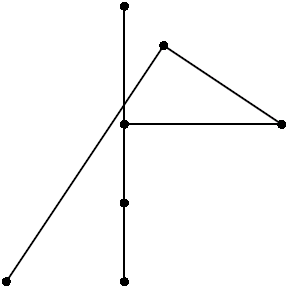| acmsguru |
|---|
| Finished |
→ Problem tags
No tags yet
No tag edit access
The problem statement has recently been changed. View the changes.
×
496. L-Shapes
Time limit per test: 0.75 second(s)
Memory limit: 262144 kilobytes
Memory limit: 262144 kilobytes
input: standard
output: standard
output: standard
Let's say that two line segments of non-zero length form an
 if they are at a
if they are at a  angle to each other and one endpoint of one segment coincides with one endpoint of the other.
angle to each other and one endpoint of one segment coincides with one endpoint of the other.There are N line segments on a plane. The segments are numbered from 1 to N. Count the number of distinct pairs of segments that form L-shapes. Two pairs are considered distinct if they contain segments with different numbers.
Input
The first line of the input line contains the integer N (1 ≤ N ≤ 5000). Each of the following N lines describes one segment and contains four integers x1, y1, x2, y2 ( ), where (x1, y1) and (x2, y2) are endpoints of the segment. It may be assumed that for each segment x1 ≠q x2 or y1 ≠q y2.
), where (x1, y1) and (x2, y2) are endpoints of the segment. It may be assumed that for each segment x1 ≠q x2 or y1 ≠q y2.Output
The output file should contain a single integer, the total number of distinct pairs of line segments forming L-shapes.Example(s)
sample input | sample output |
7 0 4 0 7 4 4 1 6 1 6 -3 0 4 4 0 4 0 0 0 4 0 0 0 2 0 4 4 4 | 5 |
Note. In the example the L-shapes are formed by the following pairs of segments: (1, 4), (1, 7), (2, 3), (4, 5), (5, 7). Note that the segments 4 and 7 coincide, but the pairs (1, 4) and (1, 7), for example, are still considered distinct.

Codeforces (c) Copyright 2010-2025 Mike Mirzayanov
The only programming contests Web 2.0 platform
Server time: Feb/21/2025 20:34:22 (h2).
Desktop version, switch to mobile version.
Supported by
User lists


| Name |
|---|




